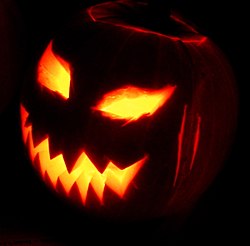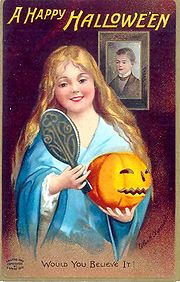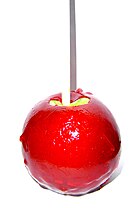Halloween
From Wikipedia, the free encyclopedia
| Halloween | |
|---|---|
 Jack-o'-lantern | |
| Also called | All Hallows’ Eve All Saints’ Eve |
| Observed by | Numerous Western countries (see article) |
| Type | Secular with roots in Christianity and paganism |
| Date | October 31 |
| Celebrations | Varies by region but includes trick-or-treating, wearing costumes, ghost tours, apple bobbing, costume parties, carving jack-o'-lanterns |
| Related to | Samhain, All Saints’ Day |
Halloween (also spelled Hallowe'en) is a holiday celebrated on October 31.
It has roots in the Celtic festival of Samhain and the Christian holy day of All Saints’ Day. It is largely a secular celebration, but some have expressed strong feelings about perceived religious overtones.[1][2][3] Irish immigrants carried versions of the tradition to North America during Ireland's Great Famine of 1846.[4]
The day is often associated with orange and black, and is strongly associated with symbols like the jack-o'-lantern. Halloween activities include trick-or-treating, wearing costumes, ghost tours, bonfires, costume parties, visiting haunted attractions, carving jack-o'-lanterns, pranking people, reading scary stories, and watching horror movies.
Contents[hide] |
[edit] History

Halloween has origins in the ancient Celtic festival known as Samhain [pronounced: sow- wen] (Irish pronunciation: [ˈsˠaunʲ]; from the Old Irish samhain, possibly derived from Gaulish samonios).[5] The festival of Samhain is a celebration of the end of the harvest season in Gaelic culture, and is sometimes[6] regarded as the "Celtic New Year".[7] Traditionally, the festival was a time used by the ancient Celtic pagans to take stock of supplies and slaughter livestock for winter stores. The ancient Celts believed that on October 31st, now known as Halloween, the boundary between the living and the deceased dissolved, and the dead become dangerous for the living by causing problems such as sickness or damaged crops. The festivals would frequently involve bonfires, into which the bones of slaughtered livestock were thrown. Costumes and masks being worn at Halloween goes back to the Celtic traditions of attempting to copy the evil spirits or placate them, in Scotland for instance where the dead were impersonated by young men with masked, veiled or blackened faces, dressed in white.[8][9]
[edit] Origin of name
The term Halloween, originally spelled Hallowe’en, is shortened from All Hallows’ Even ("All Hallows' Eve") [eve is an abbreviation of even, an older word for evening. Halloween gets -een as a contraction of even to e'en], from the Old English term eallra hālgena ǣfen meaning "All Hallow' Evening", as it is the eve of "All Hallows’ Day",[10] which is now also known as All Saints’ Day. It was a day of religious festivities in various northern European pagan traditions,[11] until Popes Gregory III and Gregory IV moved the old Christian feast of All Saints’ Day from May 13 (which had itself been the date of a pagan holiday, the Feast of the Lemures) to November 1. In the 9th century, the Church measured the day as starting at sunset, in accordance with the Florentine calendar. Although All Saints’ Day is now considered to occur one day after Halloween, the two holidays were, at that time, celebrated on the same day.
[edit] Symbols

On All Hallows’ eve, the ancient Celts would place a skeleton on their window sill to represent the departed. Originating in Europe, these lanterns were first carved from a turnip or rutabaga. Believing that the head was the most powerful part of the body, containing the spirit and the knowledge, the Celts used the "head" of the vegetable to frighten off the embodiment of superstitions.[12] Welsh, Irish and British myth are full of legends of the Brazen Head, which may be a folk memory of the widespread ancient Celtic practice of headhunting - the results of which were often nailed to a door lintel or brought to the fireside to speak their wisdom. The name jack-o'-lantern can be traced back to the Irish legend of Stingy Jack,[13] a greedy, gambling, hard-drinking old farmer. He tricked the devil into climbing a tree and trapped him by carving a cross into the tree trunk. In revenge, the devil placed a curse on Jack, condemning him to forever wander the earth at night with the only light he had: a candle inside of a hollowed turnip. The carving of pumpkins is associated with Halloween in North America[14] where pumpkins are both readily available and much larger- making them easier to carve than turnips. Many families that celebrate Halloween carve a pumpkin into a frightening or comical face and place it on their doorstep after dark. The American tradition of carving pumpkins preceded the Great Famine period of Irish immigration[15][16][17][18][19] and was originally associated with harvest time in general, not becoming specifically associated with Halloween until the mid-to-late 19th century.[20][21][22]
The imagery surrounding Halloween is largely an amalgamation of the Halloween season itself, works of Gothic and horror literature, in particular novels Frankenstein and Dracula, and nearly a century of work from American filmmakers and graphic artists,[23] and British Hammer Horror productions, also a rather commercialized take on the dark and mysterious. Halloween imagery tends to involve death, evil, the occult, magic, or mythical monsters. Traditional characters include the Devil, the Grim Reaper, ghosts, ghouls, demons, witches, pumpkin-men, goblins, vampires, werewolves, martians, zombies, mummies, pirates, skeletons, black cats, spiders, bats, owls, crows, and vultures.[24]
Particularly in America, symbolism is inspired by classic horror films (which contain fictional figures like Frankenstein's monster and The Mummy). Elements of the autumn season, such as pumpkins, corn husks, and scarecrows, are also prevalent. Homes are often decorated with these types of symbols around Halloween.
The two main colors associated with Halloween are orange and black.[25]
[edit] Trick-or-treating and guising
Trick-or-treating is a customary celebration for children on Halloween. Children go in costume from house to house, asking for treats such as candy or sometimes money, with the question, "Trick or treat?" The word "trick" refers to a (mostly idle) threat to perform mischief on the homeowners or their property if no treat is given. In some parts of Ireland and Scotland children still go guising. In this custom the child performs some sort of show, i.e. sings a song or tells a ghost story, in order to earn their treats.
[edit] Costumes
Halloween costumes are traditionally those of monsters such as ghosts, skeletons, witches, and devils. They are said to be used to scare off demons. Costumes are also based on themes other than traditional horror, such as those of characters from television shows, movies, and other pop culture icons
[edit] Costume sales
BIGresearch conducted a survey for the National Retail Federation in the United States and found that 53.3% of consumers planned to buy a costume for Halloween 2005, spending $38.11 on average (up $10 from the year before). They were also expected to spend $4.96 billion in 2006, up significantly from just $3.3 billion the previous year.[26]
[edit] UNICEF
"Trick-or-Treat for UNICEF" has become a common sight during Halloween in North America. Started as a local event in a Philadelphia suburb in 1950 and expanded nationally in 1952, the program involves the distribution of small boxes by schools (or in modern times, corporate sponsors like Hallmark, at their licensed stores) to trick-or-treaters, in which they can solicit small-change donations from the houses they visit. It is estimated that children have collected more than $118 million (US) for UNICEF since its inception. In 2006, UNICEF discontinued their Halloween collection boxes in parts of the world, citing safety and administrative concerns.[27]
[edit] Games and other activities
| This section is missing citations or needs footnotes. Please help add inline citations to guard against copyright violations and factual inaccuracies. (October 2008) |

There are several games traditionally associated with Halloween parties. One common game is dunking or apple bobbing, in which apples float in a tub or a large basin of water and the participants must use their teeth to remove an apple from the basin.[28] A variant of dunking involves kneeling on a chair, holding a fork between the teeth and trying to drop the fork into an apple[29]. Another common game involves hanging up treacle or donuts by strings; these must be eaten without using hands while they remain attached to the string, an activity that inevitably leads to a very sticky face.
Some games traditionally played at Halloween are forms of divination. In Puicíní (pronounced "poocheeny"), a game played in Ireland, a blindfolded person is seated in front of a table on which several saucers are placed. The saucers are shuffled, and the seated person then chooses one by touch; the contents of the saucer determine the person's life during the following year. In 19th-century Ireland, young women placed slugs in saucers sprinkled with flour.[30][31] A traditional Irish and Scottish form of divining one's future spouse is to carve an apple in one long strip, then toss the peel over one's shoulder. The peel is believed to land in the shape of the first letter of the future spouse's name. This custom has survived among Irish and Scottish immigrants in the rural United States.[citation needed]
Unmarried women were told[who?] that if they sat in a darkened room and gazed into a mirror on Halloween night, the face of their future husband would appear in the mirror. However, if they were destined to die before marriage, a skull would appear. The custom was widespread enough to be commemorated on greeting cards from the late 19th and early 20th centuries.
The telling of ghost stories and viewing of horror films are common fixtures of Halloween parties. Episodes of TV series and specials with Halloween themes (with the specials usually aimed at children) are commonly aired on or before the holiday, while new horror films, are often released theatrically before the holiday to take advantage of the atmosphere.
[edit] Haunted attractions
Haunted attractions are entertainment venues designed to thrill and scare patrons; most are seasonal Halloween businesses. Origins of these paid scare venues are difficult to pinpoint, but it is generally accepted that they were first commonly used by the Junior Chamber International (Jaycees) for fundraising.[32] They include haunted houses, corn mazes, and hayrides,[33] and the level of sophistication of the effects has risen as the industry has grown. Haunted attractions in the United States bring in an estimate $300–500 million each year, and draw some 400,000 customers, although trends suggest a peak in 2005[32]. This increase in interest has led to more highly technical special effects and costuming that is comparable with that in Hollywood films.[34]
[edit] Foods
Because the holiday comes in the wake of the annual apple harvest, candy apples (known as toffee apples outside North America), caramel or taffy apples are a common Halloween treat made by rolling whole apples in a sticky sugar syrup, sometimes followed by rolling them in nuts.
At one time, candy apples were commonly given to children, but the practice rapidly waned in the wake of widespread rumors that some individuals were embedding items like pins and razor blades in the apples.[35] While there is evidence of such incidents,[36] they are quite rare and have never resulted in serious injury. Nonetheless, many parents assumed that such heinous practices were rampant. At the peak of the hysteria, some hospitals offered free x-rays of children's Halloween hauls in order to find evidence of tampering. Virtually all of the few known candy poisoning incidents involved parents who poisoned their own children's candy, and there have been occasional reports of children putting needles in their own (and other children's) candy in need of a bit of attention.[citation needed]
One custom that persists in modern-day Ireland is the baking (or more often nowadays, the purchase) of a barnbrack (Irish "báirín breac"), which is a light fruitcake, into which a plain ring, a coin and other charms are placed before baking. It is said that those who get a ring will find their true love in the ensuing year. This is similar to the tradition of king cake at the festival of Epiphany.
Other foods associated with the holiday:
- Apple cider
- Báirín Breac (Ireland)
- Bonfire toffee (in the UK)
- Candy corn
- Chocolates, caramels, and gum
- Cider
- Colcannon (Ireland)
- "Fun-sized" or individually wrapped pieces of small candy, typically in Halloween colors of orange, and brown/black.
- Novelty candy shaped like skulls, pumpkins, bats, worms, etc.
- Popcorn
- Pumpkin and apple pie ice cream.
- Pumpkin pie and pumpkin bread
- Roasted pumpkin seeds
- Roasted sweet corn
- Small bags of potato chips, pretzels and caramel corn
[edit] Around the world
With its roots in Celtic cultures, Halloween is not celebrated in all countries and regions of the world, and among those that do the traditions and importance of the celebration vary significantly. Celebration in the United States has had a significant impact on how the holiday is observed in other nations. The history of Halloween traditions in a given country also lends context to how it is presently celebrated.
[edit] Religious perspectives
In North America, Christian attitudes towards Halloween are quite diverse. In the Anglican Church, some dioceses have chosen to emphasize the Christian traditions of All Saints’ Day,[37][38] while some other Protestants celebrate the holiday as Reformation Day, a day of remembrance and prayers for unity.[39] Celtic Christians may have Samhain services that focus on the cultural aspects of the holiday, in the belief that many ancient Celtic customs are "incompatible with the new Christian religion. Christianity embraced the Celtic notions of family, community, the bond among all people, and respect for the dead. Throughout the centuries, pagan and Christian beliefs intertwine in a gallimaufry (hodgepodge) of celebrations from October 31 through November 5, all of which appear both to challenge the ascendancy of the dark and to revel in its mystery."[40]
Many Christians ascribe no negative significance to Halloween, treating it as a purely secular holiday devoted to celebrating "imaginary spooks" and handing out candy. Halloween celebrations are common among Roman Catholic parochial schools throughout North America and in Ireland. In fact, the Roman Catholic Church sees Halloween as having a Christian connection.[41] Father Gabriele Amorth, a Vatican-appointed exorcist in Rome, has said, "[I]f English and American children like to dress up as witches and devils on one night of the year that is not a problem. If it is just a game, there is no harm in that."[1] Most Christians hold the view that the tradition is far from being "satanic" in origin or practice and that it holds no threat to the spiritual lives of children: being taught about death and mortality, and the ways of the Celtic ancestors actually being a valuable life lesson and a part of many of their parishioners' heritage.[40] Other Christians feel concerned about Halloween, and reject the holiday because they believe it trivializes (and celebrates) "the occult" and what they perceive as evil.[2] A response among some fundamentalists in recent years has been the use of Hell houses or themed pamphlets (such as those of Jack T. Chick) which attempt to make use of Halloween as an opportunity for evangelism.[42] Some consider Halloween to be completely incompatible with the Christian faith[43] due to its origin as a pagan "Festival of the Dead." In more recent years, the Roman Catholic Archdiocese of Boston has organized a "Saint Fest" on the holiday.[42] Many contemporary Protestant churches view Halloween as a fun event for children, holding events in their churches where children and their parents can dress up, play games, and get candy.
Religions other than Christianity also have varied views on Halloween. Some Wiccans feel that the tradition is offensive to "real witches" for promoting stereotypical caricatures of "wicked witches".[3]
In Arab countries where it is celebrated, devotion is given to St. Barbara.
[edit] See also
[edit] References
- ^ a b Gyles Brandreth, "The Devil is gaining ground" The Sunday Telegraph (London), March 11, 2000.
- ^ a b Halloween: Satan's New Year (2006) by Billye Dymally, Halloween: Counterfeit Holy Day (2005) by Kele Gershom, and Halloween: What's a Christian to Do? (1998) by Steve Russo. An opposing viewpoint is found in The Magic Eightball Test: A Christian Defense of Halloween and All Things Spooky (2006) by Lint Hatcher.
- ^ a b Reece, Kevin (2004-10-24). "School District Bans Halloween". KOMO News. http://www.komonews.com/news/archive/4136266.html. Retrieved 2006-09-14.
- ^ "Halloween Comes to America". A&E Television Networks. http://www.history.com/minisite.do?content_type=Minisite_Generic&content_type_id=715&display_order=1&sub_display_order=2&mini_id=1076. Retrieved 2008-11-12.
- ^ Nicholas Rogers, "Samhain and the Celtic Origins of Halloween," Halloween: From Pagan Ritual to Party Night (New York: Oxford University Press, 2002), 11-21.
- ^ Hutton, Ronald (1996) Stations of the Sun: A History of the Ritual Year in Britain. Oxford, Oxford University Press ISBN 0192880454
- ^ Danaher, Kevin (1972) The Year in Ireland: Irish Calendar Customs Dublin, Mercier. ISBN 1-85635-093-2 pp.190–232
- ^ Campbell, John Gregorson (1900, 1902, 2005) The Gaelic Otherworld. Edited by Ronald Black. Birlinn Ltd. ISBN 1-84158-207-7 pp.559-62
- ^ Arnold, Bettina (2001-10-31). "Halloween Customs in the Celtic World". University of Wisconsin-Milwaukee. http://www.uwm.edu/~barnold/lectures/holloween.html. Retrieved 2007-10-16.
- ^ Simpson, John; Weiner, Edmund (1989). Oxford English Dictionary (second ed.). London: Oxford University Press. ISBN 0-19-861186-2. OCLC 17648714.
- ^ Danaher, Kevin (1972) The Year in Ireland: Irish Calendar Customs Dublin, Mercier. ISBN 1-85635-093-2 pp.190–232
- ^ "Halloween and the jack-o-lantern". Witchway.net. http://www.witchway.net/hallows/jack.html. Retrieved 2008-10-31.
- ^ History of the Jack O'Lantern, Pumpkin Nook
- ^ Skal, David J. (2002). Death Makes a Holiday: A Cultural History of Halloween. New York: Bloomsbury, 34. ISBN 1-58234-230-X.
- ^ Family Days Out - Family days out
- ^ Wallcoo.net
- ^ Kakvo.org (Bulgarian)
- ^ Halloween Fright
- ^ Guet.edu.cn
- ^ Family Days Out - Family days out
- ^ Wallcoo.net
- ^ Kakvo.org (Bulgarian)
- ^ Nicholas Rogers, "Halloween Goes to Hollywood," Halloween: From Pagan Ritual to Party Night (New York: Oxford University Press, 2002), 103-124.
- ^ Hal Siemer, Spooky Halloween: A Celebration of the Dark., QuestMagazine.com.
- ^ Steven Heller. Halloween: Vintage Holiday Graphics. Taschen. 2005.
- ^ Grannis, Kathy; Scott Krugman (September 20, 2006). "As Halloween Shifts to Seasonal Celebration, Retailers Not Spooked by Surge in Spending" (HTML). National Retail Federation. http://www.nrf.com/content/default.asp?folder=press/release2006&file=halloween06.htm. Retrieved 31 October 2006.
- ^ Beauchemin, Genevieve; CTV.ca News Staff (2006-05-31). "UNICEF to end Halloween 'orange box' program". CTV. http://www.ctv.ca/servlet/ArticleNews/story/CTVNews/20060530/unicef_orange_060530?s_name=&no_ads=. Retrieved 2006-10-29.
- ^ Kids-Fun-And-Games.com
- ^ "Halloween Party Game Ideas" Kidzworld.com. Retrieved on 2009-03-17.
- ^ Economicexpert.com
- ^ Everything Preschool - Early Childhood Education Made Easy
- ^ a b Associated Press (2005-10-30). "Haunted house business getting frightfully hard". MSNBC.com. MSNBC. http://www.msnbc.msn.com/id/9855272/. Retrieved 2008-11-18.
- ^ Greg Ryan (2008-09-17). "A Model of Mayhem". Hudson Valley Magazine. http://www.hvmag.com/Hudson-Valley-Magazine/October-2008/A-Model-of-Mayhem/. Retrieved 2008-10-06.
- ^ Wilson, Craig (2006-10-12). "Haunted houses get really scary". USAToday.com. http://www.usatoday.com/life/lifestyle/2006-10-11-haunted-house-main_x.htm.
- ^ Nicholas Rogers, "Razor in the Apple: Struggle for Safe and Sane Halloween, c. 1920-1990," Halloween: From Pagan Ritual to Party Night (New York: Oxford University Press, 2002), 78-102.
- ^ "Urban Legends Reference Pages: Pins and Needles in Halloween Candy". Snopes.com. http://www.snopes.com/horrors/mayhem/needles.asp. Retrieved 2008-10-31.
- ^ "Bishop challenges supermarkets to lighten up Halloween" (HTML). www.manchester.anglican.org. n.d.. http://www.cofe.anglican.org/news/pr9106.html. Retrieved 2006-10-22.
- ^ "Halloween and All Saints Day" (HTML). newadvent.org. n.d.. http://www.newadvent.org/cathen/01315a.htm. Retrieved 2006-10-22.
- ^ "Reformation Day: What, Why, and Resources for Worship" (HTML). The General Board of Discipleship of The United Methodist Church. 2005-10-21. http://www.gbod.org/worship/default.asp?act=reader&item_id=15084&loc_id=9,612,32,52. Retrieved 2006-10-22.
- ^ a b "Feast of Samhain/Celtic New Year/Celebration of All Celtic Saints November 1" (HTML). All Saints Parish. n.d.. http://allsaintsbrookline.org/celtic/samhain.html. Retrieved 2006-11-22.
- ^ Halloween’s Christian Roots AmericanCatholic.org. Retrieved on October 24, 2007.
- ^ a b "Salem 'Saint Fest' restores Christian message to Halloween" (HTML). www.rcab.org. n.d.. http://www.rcab.org/Pilot/2004/ps041105/saintfest.html. Retrieved 2006-10-22.
- ^ ""Trick?" or "Treat?"—Unmasking Halloween" (HTML). The Restored Church of God. n.d.. http://www.thercg.org/articles/totuh.html. Retrieved 2007-09-21.
[edit] Further reading
- Diane C. Arkins, Halloween: Romantic Art and Customs of Yesteryear, Pelican Publishing Company (2000). 96 pages. ISBN 1-56554-712-8
- Diane C. Arkins, Halloween Merrymaking: An Illustrated Celebration Of Fun, Food, And Frolics From Halloweens Past, Pelican Publishing Company (2004). 112 pages. ISBN 1-58980-113-X
- Lesley Bannatyne, Halloween: An American Holiday, An American History, Facts on File (1990, Pelican Publishing Company, 1998). 180 pages. ISBN 1-56554-346-7
- Lesley Bannatyne, A Halloween Reader. Stories, Poems and Plays from Halloweens Past, Pelican Publishing Company (2004). 272 pages. ISBN 1-58980-176-8
- Phyllis Galembo, Dressed for Thrills: 100 Years of Halloween Costumes and Masquerade, Harry N. Abrams, Inc. (2002). 128 pages. ISBN 0-8109-3291-1
- Lint Hatcher, The Magic Eightball Test: A Christian Defense of Halloween and All Things Spooky, Lulu.com (2006). ISBN 978-1847287564
- Ronald Hutton, Stations of the Sun: A History of the Ritual Year in Britain, Oxford Paperbacks (2001). 560 pages. ISBN 0-19-285448-8
- Jean Markale, The Pagan Mysteries of Halloween: Celebrating the Dark Half of the Year (translation of Halloween, histoire et traditions), Inner Traditions (2001). 160 pages. ISBN 0-89281-900-6
- Lisa Morton, The Halloween Encyclopedia, McFarland & Company (2003). 240 pages. ISBN 0-7864-1524-X
- Nicholas Rogers, Halloween: From Pagan Ritual to Party Night, Oxford University Press (2002). 198 pages. ISBN 0-19-514691-3
- Jack Santino (ed.), Halloween and Other Festivals of Death and Life, University of Tennessee Press (1994). 280 pages. ISBN 0-87049-813-4
- David J. Skal, Death Makes A Holiday: A Cultural History of Halloween, Bloomsbury USA (2003). 224 pages. ISBN 1-58234-305-5
- Ben Truwe, The Halloween Catalog Collection. Portland, Oregon: Talky Tina Press (2003). ISBN 0-9703448-5-6.








No comments:
Post a Comment